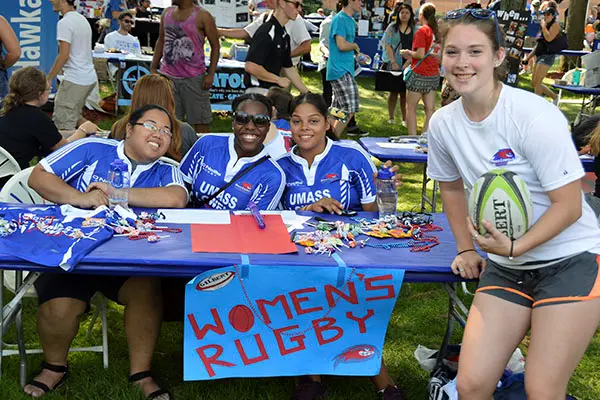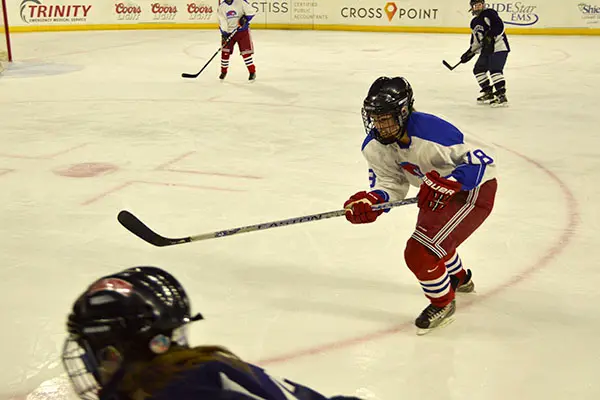As Participation Booms, Campus Rec Keeps Focus on Individual Growth
 Image by Ed Brennen
Image by Ed Brennen
05/16/2016
By Ed Brennen
The national championship tournament bracket featured many of the usual men’s college basketball powerhouses: Michigan State, Ohio State, Georgetown and … UMass Lowell?
OK, it wasn’t the NCAA Division I “March Madness” tournament that spawns countless office pools each year. But for the UMass Lowell club men’s basketball team, April’s National Club Basketball Association championship tourney at La Roche College in Pittsburgh was as big as it gets.
“It’s mind-boggling. You never think we’d be up to that caliber, playing those types of teams,” says club founder, president, coach and guard, junior Danny Meas, whose seventh-seeded River Hawks fell to second-seeded Ohio State, 87-63, but bounced back to win a pair of consolation-round games.
 Image by Campus Recreation
Image by Campus Recreation
Men’s basketball was one of several club teams to compete on the national stage during the 2015-16 academic year — a testament to both the commitment of the student-athletes and the work being done by Campus Recreation to grow the club sports program and help students lead happier and healthier lives. Others included:
- The men’s rugby team, which competed at the USA Rugby Round of 16 nationals in Pittsburgh in November and has also qualified for the 7s nationals on Memorial Day weekend in Cary, N.C.
- The ballroom dance team, which finished second at November’s USA Dance National Collegiate DanceSport Championship in Columbus, Ohio.
- The cheerleading team, which advanced to the National Cheerleaders Association championship in Daytona Beach, Fla., in April.
- The dance team, which competed at April’s National Dance Alliance championship in Daytona Beach.
- The cricket team, which played in the American College Cricket Dream11 national championship tournament in March in Fort Lauderdale, Fla.
“Club sports are a great way to teach students leadership skills and develop as individuals,” says Nick Lowery, who was hired as coordinator of club sports and business operations in 2013 — the same year the university’s athletics program moved up to Div. I and Campus Rec was shifted from the Athletics Department to Student Affairs.
In the three years since, the number of students participating in club sports has nearly doubled (from 427 to 789) and 13 new club teams have been added, bringing the total to 34. Intramural sports have seen similar explosive growth, with nearly 6,000 students participating annually, up 70 percent from three years ago.
“We’ve definitely been able to give the clubs more support, particularly in coaching and athletic training,” says Campus Recreation Director Peter Murray, who notes that the club sports budget has grown from $35,000 to more than $100,000 since moving under the auspices of Student Affairs.
‘Like a family’
That is great news for former high school student-athletes like Meas, who might not make the cut at the Div. I level but still want to play sports in college.
“It was hard to give up basketball,” says Meas, who played at Lowell High School but didn’t think he could make the River Hawks as a walk-on. So instead the criminal justice major founded the club men’s basketball team in 2013.
 Image by Campus Recreation
Image by Campus Recreation
“Transitioning from high school to college isn’t easy for a lot of people, but playing club sports makes it easier,” says Meas, who believes playing a club sport has strengthened his connection to the university.
“When I first got here as a freshman I thought getting involved was kind of corny, but being part of the club team, it’s like a family. It’s a big reason why you’re here.”
Junior exercise physiology major Shannon MacDonald has danced for as long as she can remember, so being able to continue her competitive dance career in college was “really important.” The Lowell native is now co-captain of the club dance team.
“As a dancer from this area, there is this huge misconception that you can only dance in college if you major in it,” MacDonald says. “I wanted to focus more on school than dance, but I still wanted to improve my skills. The dance team was perfect for me.”
As a commuter student, MacDonald says participating in a club sport has also given her a sense of belonging on campus. “If I was a commuter who went to class and then just went home,” she says, “I wouldn’t really care as much about everything that’s happening at the university.”
More than fun and games
While club sports provide students with a structured way to stay fit and satisfy their competitive drive, they also offer the opportunity to learn valuable organizational, communication and business skills.
“It’s almost like they’re running their own small business,” Murray says. “They have to recruit athletes, manage a budget, fundraise, handle communication and coordinate their groups. The student leadership opportunity is pretty amazing.”
Teams, which fall into “competitive,” “performance-based” and “recreational” categories, request an operating budget from Campus Rec each year to help pay for things like coaches, equipment, uniforms and travel expenses. To cover any shortfalls, teams also charge players participation fees and engage in fundraising — to the tune of nearly $250,000 combined annually.
Many of the competitive teams play in regional conferences and, with the help of Campus Rec, are responsible for scheduling their practices (usually three to four per week) and games, as well as hiring officials and athletic trainers. There is even a concussion protocol in place with the training staff that an athlete must clear before returning to play.
“Being an officer in a club sports organization has definitely helped get my organizational skills in check,” MacDonald says. “I have learned so much about fundraising, running events and organizing travel — skills that are helping me in everyday life.”
“Those skills help develop them academically,” adds Lowery, who says the key for successful club teams like hockey, rugby and lacrosse is a stable leadership structure. That’s why he and his staff are creating transition binders for each club, a historical record of team results and alumni contact information that can be handed down from year to year.
 Image by Campus Recreation
Image by Campus Recreation
“It’s important for captains to have this history so we can say, ‘OK, it’s your team’s fifth anniversary, you can get alumni together for a game,’ ” Lowery says.
Campus Rec also endowed a club sports scholarship three years ago. After awarding two $100 scholarships to its top student leaders the past two years, the scholarships grew to $500 this year.
“Our biggest goal is to continue to support students and their interests,” says Murray, who recalls there being about a dozen club teams on campus when he arrived 11 years ago. “When students have a great idea and they’re excited and passionate about their sport, we do our best to support them in pursuing it. Students are seeing the opportunity and taking it to places we can’t even imagine.”



